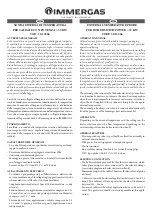
Shifting the Heating Curve
(a) Manually, at the control:
The Occupied and Unoccupied dials on this control can shift the WWSD
point up or down from 35 to 105
°
F (2 to 41
°
C).
(b) Automatically, using room temperature feedback:
In addition to a Supply Sensor and an Outdoor Sensor, this control can use
a tekmar RTU, Zone Control or Indoor Sensor to provide room temperature
feedback for added comfort and system flexibility.
The control still calculates a desired supply temperature based on the
Heating Curve setting and the outdoor temperature.
If the air temperature in the room is too cold, the control will shift the Heating
Curve (and WWSD point)
up, which raises the supply temperature until the
room warms up again.
If the air temperature in the room is too warm, the control will shift the Heating
Curve (and WWSD point)
down, which lowers the supply temperature until
the room cools down.
Correct setting and shifting of the Heating Curve... the key to More Comfort and Energy Savings.
Heating Curve
As outdoor temperatures become colder, heat losses from a building increase, which requires the addition of more heat to prevent
the indoor air temperature from also becoming colder. This tekmar reset control measures the outdoor temperature and as the outdoor
temperature becomes colder, it balances the heat loss by making the heating supply water hotter.
The Heating Curve is used to calculate exactly how hot to make the supply water at different outdoor temperatures. It determines
the number of degrees the supply water temperature is raised for each degree the outdoor temperature falls.
Setting the Heating Curve
Two examples of how the Heating Curve works are illustrated in the following diagram.
—With a 2.4 Curve, the supply water temperature is raised 2.4 degrees for every degree of outdoor temperature drop.
If: WWSD point = 70
°
F and Outdoor temperature = 30
°
F, then supply temperature = 166
°
F
—With a 0.6 Curve, the supply water temperature is raised 0.6 degrees for every degree of outdoor temperature drop.
If: WWSD point = 70
°
F and Outdoor temperature = 30
°
F, then supply temperature = 94
°
F
2
• If the Heating Curve selected is too low; the heating system will not
supply hot enough water to keep the room temperature warm during
colder weather.
• If the Heating Curve selected is too high; the supply water will be too hot
for the conditions and the building will overheat during colder weather.
Warm Weather Shut Down (WWSD)
At warm outdoor temperatures, the indoor space of a building gains heat
from the outdoors; additional heat is not required, and if the heating system
is running (even on standby), enough excess heat can be produced to
overheat the building, causing discomfort and wasting valuable energy.
This control shuts off the boiler(s) and system pump when the outdoor
temperature is above the WWSD point.
As outdoor temperatures get colder, there comes a point where the heat
gain turns into heat loss; the heat loss causes the indoor temperature to fall
below the comfort level, and the heating system must be turned on to start
delivering heat.
Refer to the tekmar Essays E 001 and E 002 for more detailed information regarding control strategy and integration of control functions.
A very cool room temperature can shift the curve far enough up to bring the control out of WWSD at warm outdoor temperatures.
A very warm room temperature can shift the curve far enough down to put the control into WWSD at cool outdoor temperatures.
To provide heat to the building, this control turns on the system pump and cycles the boiler(s) to deliver heat at the low output required
by the Heating Curve near the WWSD point.
When the system is operating near the WWSD point and the building is too cold; the WWSD point should be raised.
When the system is operating near the WWSD point and the building is too warm; the WWSD point should be lowered.
Outdoor Reset Strategy
Outdoor air temperature
Supply water temperature
50
(10)
30
(-1)
10
(-12)
-10
°
F
(-23)
°
C
110
(43)
70
(21)
70
(21)
90
(32)
210
(99)
170
(77)
150
(65)
130
(54)
190
(88)
3.6 3.0 2.4 2.0
1.6
0.8
0.4
1.0
0.6
90
(32)
50
°
F
(10)
°
C
Heating
Curve
WWSD
Point
1.2
Outdoor air temperature
Supply water temperature
50
(10)
30
(-1)
10
(-12)
-10
°
F
(-23)
°
C
110
(43)
70
(21)
70
(21)
90
(32)
210
(99)
170
(77)
150
(65)
130
(54)
190
(88)
3.6 3.0 2.4 2.0
1.6
0.8
0.4
1.0
90
(32)
50
°
F
(10)
°
C
Heating
Curve
WWSD
Point
will
shift
up and
down
with
shift of
Heating
Curve
1.2
UP
DOWN
UP
DOWN
Parallel Shift of Heating Curve
0.6






























